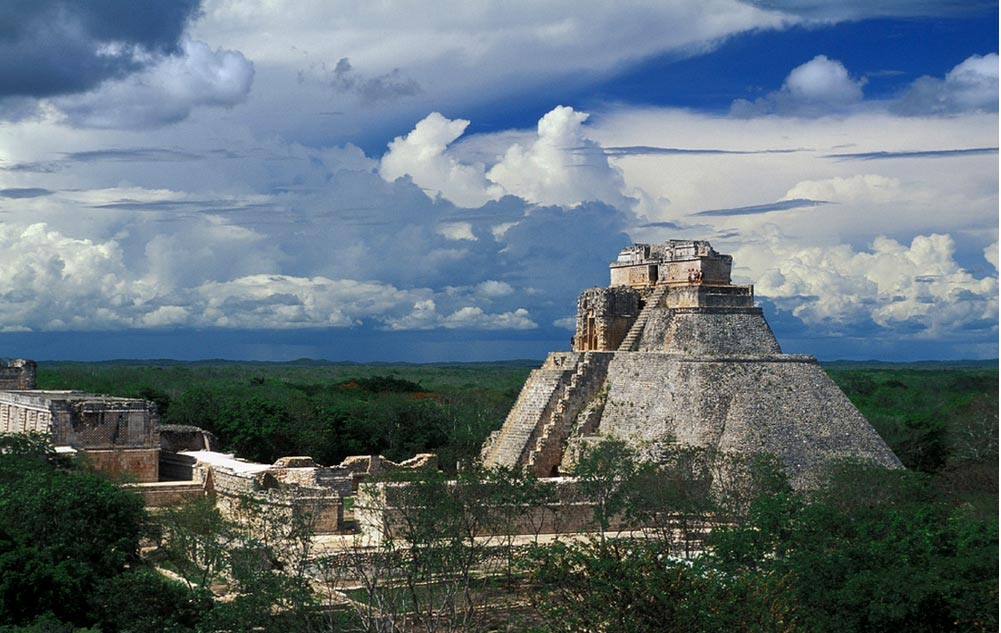Approximately 4,000 years ago, in modern-day southern Mexico and Central America, the Mayan civilization arose and, in due time, spread. Over thousands of years, the Mayans developed a highly sophisticated urban society, numbering 19 million people at its peak. The Mayans built and thrived in dense, teeming metropolises, erecting giant limestone pyramids that continue to draw throngs of tourists to this day. Yet, when the Spanish arrived in the 16th century, they found a landscape dotted with empty cities and opulent ruins. For years, the demise of the Maya puzzled scientists and historians alike.
Scientists now believe that a series of droughts beginning in the eighth century AD, exacerbated by the effects of deforestation, pushed the Mayans toward collapse. Crops failed, cities fell, and the people fled to the coast.
Today, new field methods are allowing scientists to peer into the past to better understand not only the factors leading to the Mayan collapse, but the enduring consequences of their actions, all the more unsettling in light of ongoing efforts to curb climate change.
The capacity of trees to sequester carbon is well understood: Reforestation on a mass scale has been touted time and time again as a crucial measure against global heating. However, the role that soils play in carbon cycling remains relatively under-researched despite the fact that the soils of the world hold over twice as much carbon as the atmosphere. When trees are felled or burned to make way for pasture or crop land, much of the carbon held in the trees and soil is released into the atmosphere. Some postulate that this release of sequestered carbon can be countered with the regrowth of previously denuded forest. However, a study published in Nature Geoscience in 2018 suggests otherwise.
Peter Douglas, an assistant professor in McGill’s Department of Earth and Planetary Sciences, was part of the team analyzing plant wax lipids in lakebed sediments for the study. These organic molecules, produced by plants, have a tendency to bind to minerals within the soil before they are eventually washed away.
Douglas found a curious discrepancy between the ages of the plant waxes and the sediments that they were found in. The team discovered that this gap varied greatly from one period of time to the next; on the whole, the plant waxes were far older than the sediment.
“Basically, [the plant wax lipids] give us a picture of how long carbon is sitting in soils,” Douglas said in an interview with The McGill Tribune. “Soils are a huge carbon reservoir on the planet [….] But we don’t really know how that kind of storage reservoir changes over time, especially on long time scales. What we found is that it really decreased a lot over the course of Mayan history.”
Douglas believes that the findings indicate that Mayan deforestation sped up the movement of soil carbon into lake beds: The soil retained carbon for far less time than it had prior.
“What is perhaps even more interesting is that when the Maya had major depopulation and the forest grew back, the age of the carbon didn’t go back up,” Douglas said. “The soils did not regain their capacity to store carbon on long time scales.”
This means that reforestation, while helpful in recapturing atmospheric carbon, might not be quite the silver bullet some have hoped. In the meantime, further research on long-term soil carbon storage capacity is in order.
“For the time being, scientists are unaware if this is a widespread phenomenon,” Douglas said.
If so, it does not bode especially well for humanity. According to Douglas, the findings suggest that it might take a very long time, upwards of thousands of years, to fully rebalance carbon storage levels in soils. In the meantime, one can only hope that our own civilization will avert the fate faced by the Maya.








